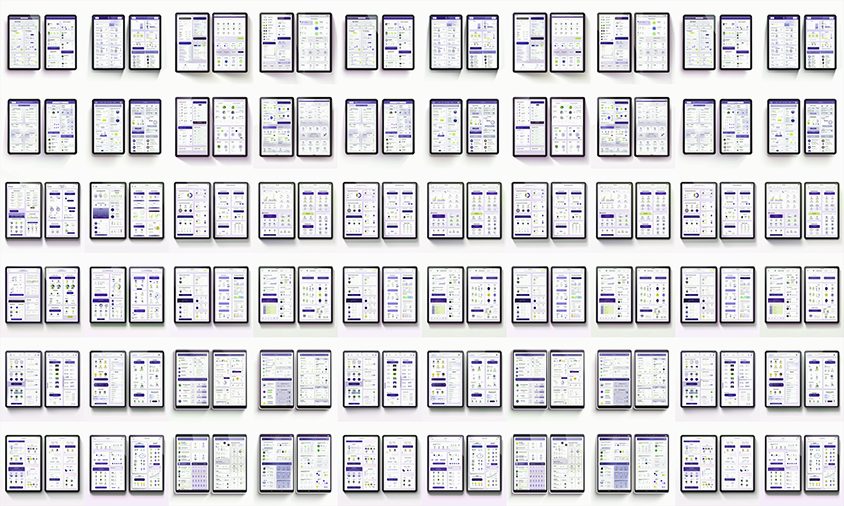IQVIA MedTech Market Activator Platform
Project Background
Through meticulous execution and strategic envisioning, a user-friendly mobile application was developed, redefining tablet experiences.
As a product designer, I took a comprehensive role in steering both the strategic and execution aspects of the design, crafting the product’s vision, and ensuring its successful prototyping and iteration. From January to December 2021, I established the design system, developed UI/UX concepts, iterated the product structure, and refined several design versions. This application is fully responsive, with the primary use case being on tablets.
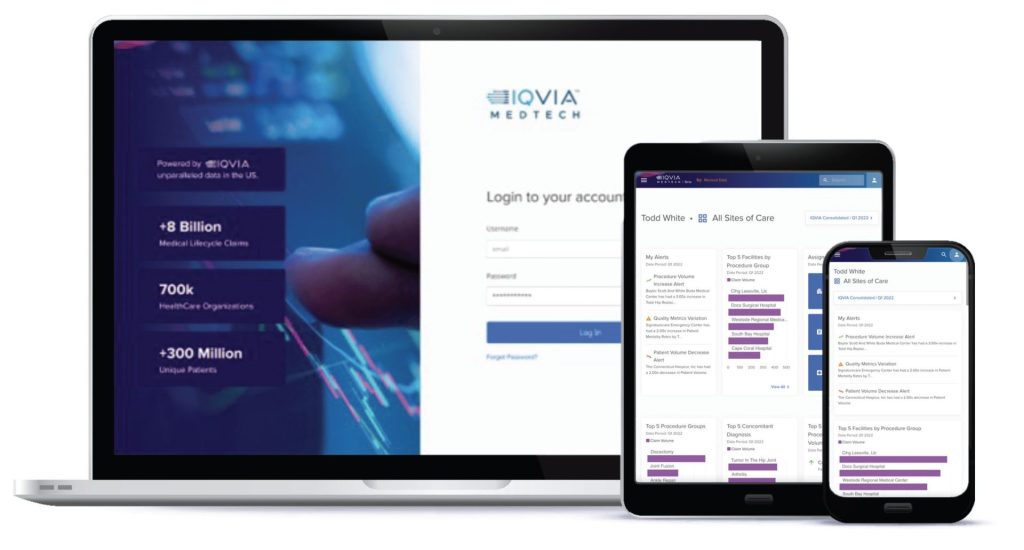
Content
A groundbreaking product was developed, transforming cluttered medical sales data into consolidated, actionable insights for users like Jessica.
Jessica is a medical sales executive specializing in knee replacements. She spends hours before each sales call sorting through medical sales data in Power BI, attempting to discern the needs and opportunities with her client doctors. Often, she struggles to find the information she is looking for, misses significant changes, and fails to identify opportunities. She also faces difficulties when she has to present multifaceted data to her clients in an understandable manner. Jessica’s company, the government, and third parties provide abundant data on hospitals, doctors, and procedures, but it is cluttered and confusing. Jessica desires a consolidated and efficient way to visualize and interpret this data. My goal was to reshape this context into a product that transforms data complexity into actionable insights, creating a seamless experience for Jessica and her peers.
Process
Utilizing LUMA HCD and Lean UX, the process entailed collaborative, user-centric design aligning with organizational strategy and market viability.
In my product design approach, I implemented some of the LUMA HCD methodology; my process began with understanding the current pain points of MedTech professionals and capturing challenges. In addition to using the LUMA methodology, I utilized Lean UX principles to ensure the product was user-centric and met business goals. The product has gone through an alpha, beta, and release phase.
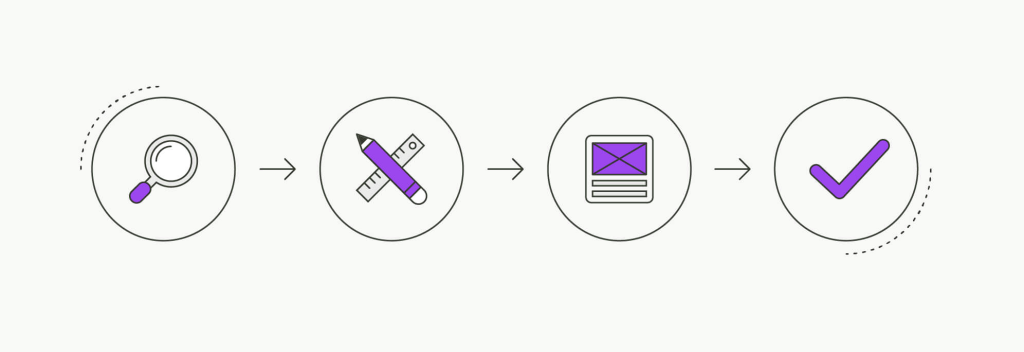
Alongside the LUMA HCD methodology, my process also involved working closely with cross-functional teams, including developers and business analysts, ensuring the seamless translation of design into development and aligning the product’s trajectory with organizational strategy and market viability.
Research
In-depth research involving user interviews and technology evaluations, played a pivotal role in unveiling profound needs in the MedTech domain.
User Interviews: I talked with MedTech professionals, sales teams, and other stakeholders. These discussions gave me deep insights into their challenges, particularly during on-site engagements.
Stakeholder Workshops: I was tasked with leading workshops and brainstorming sessions, held three times a week for half an hour, with the primary participants being sales executives and medical professionals. These sessions aimed to create solutions and reach agreements amongst stakeholders collectively. By involving a range of perspectives, I enhanced the product’s functionality and appeal significantly.
Technology Evaluation: I carried out a thorough exploration of several technology tools and platforms to identify the ones most capable of managing large datasets and performing high-level analytics with ease. This included an evaluation of Elastic Search, known for its fast data retrieval capabilities, and TensorFlow, distinguished for its advanced predictive analytics.
The aim of this meticulous review was to pinpoint solutions that could not only handle substantial data efficiently but also be effectively considered during the design process. These tools were to aid in generating accurate and insightful analysis, enabling my team to make informed decisions grounded on a comprehensive exploration and understanding of the data. It was vital to ensure that the selected technologies were scalable, fast, precise, and could adapt to various large datasets.
By considering these technologies in the design process, I aspire to develop interfaces and experiences that are user-friendly and insightful, making the derived insights easily understandable and actionable. This approach is intended to cultivate a setting where design solutions are informed and enriched by data from the initial stages of development.
Competitive Analysis: In the competitive market with platforms like Snowflake, Veeva, and Power BI, IQVIA is not just a contender, but it possesses substantial potential to become a leader in the specialized MedTech sector.
Snowflake is renowned for its advanced data warehousing, offering scalable data solutions and intricate analytics to various industries. IQVIA can leverage these offerings by integrating Snowflake’s technology to improve user interaction on its platforms. By doing this, IQVIA can focus on enhancing the frontend user experience, leaving the backend complexities to Snowflake. This collaboration could result in faster, more intuitive data retrieval and analytics for users.
Veeva, much like IQVIA, primarily serves the life sciences industry with its specialized cloud solutions. The competitive edge for IQVIA here is its potential to offer a richer pool of data and a more focused user experience (UX) designed specifically for the MedTech sector. By doing so, it can deliver more streamlined and intuitive interfaces that are precisely tailored to meet the unique needs and preferences of its clients in the medical technology sector.
Lastly, Power BI stands out for its capabilities in business analytics and the visualization of data, serving a broad range of sectors. However, it typically needs to be customized for specialization in MedTech. IQVIA, with its specialized approach, can offer a more tailored experience to users in the medical technology field right out of the box. In essence, in a landscape filled with generalized solutions, IQVIA’s specialized, user-friendly, and data-rich approach places it in a prime position to not only compete effectively but also to lead in the MedTech sector.
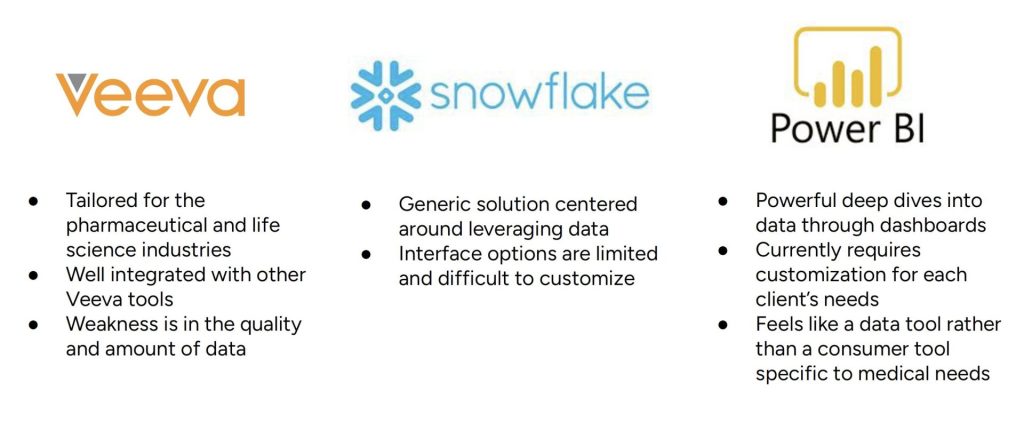
Research Insights
Deep insights revealed the necessity for a focused, user-friendly solution enabling Medical Sales Executives to navigate critical data intuitively.
Medical Sales Executives need an app narrowly focused on the doctor, hospital, or procedure they are currently investigating.
Medical Sales Executives need a solution that is user-friendly and organizes data efficiently. This solution should intuitively guide them to insights, and help them make more informed decisions. They require easy access to comprehensive data about doctors, hospitals, and procedures that allow for effective and efficient sales strategies.
Anomalies that affect profitability positively or negatively are important pieces of data.
Anomalies, by definition, deviate from the norm. Negative anomalies that affect profitability may indicate that a doctor is unhappy or has a negative experience with a product and will be ordering less. On the other hand, positive anomalies suggest areas with an unexpected increase in sales or interest. This could present an opportunity.
Medical Sales Executives need a scalable solution connected to organizational, financial, and historical information.
MSEs need to compare current performance against records to gauge growth and identify areas of improvement. MSEs need to see how a doctor is connected to a hospital, other physicians, and procedures. It is also helpful for the salesperson to see what impact a doctor or hospital has on sales goals without switching applications.
Tailoring to Specific Industry Needs
The interface was tailored explicitly for the MedTech industry, addressing their unique needs and enhancing productivity and user satisfaction.
Design Goals
The design aimed to structure essential data visually and efficiently, facilitating quick, informed decision-making for Medical Sales Executives.
I aimed to create a product that offers a structured, efficient, and comprehensive view of essential data, enabling Medical Sales Executives to navigate through vast amounts of information easily and make informed decisions promptly. This also involves presenting data in a visually appealing manner, ensuring it is easily interpretable and actionable.
Drawing upon the research insights, I strategized the product roadmap, feature prioritization, and release planning, delivering high-impact functionalities that align with user needs and business objectives.
Design Problems
The envisioned product stands as a synonym for responsive, efficient, and user-customized design, resolving the need for prioritized information.
Users need time-sensitive information that affects financial outcomes.
Medical Sales Executives require prioritized, real-time information tailored to financial outcomes through a responsive application. These alerts should offer concise, contextual information with actionable options, ensuring immediate understanding and response regardless of the device used. An efficient alert system incorporates user customization, historical tracking, and feedback mechanisms to optimize its relevance and effectiveness continuously.

Sales Executives need to traverse complex data connections quickly and easily.
It is imperative to address the challenges faced by Medical Sales Executives when dealing with intricate data connections. These professionals require a seamless and efficient user experience that not only presents data in a clear and organized manner but also offers features that aid in swift navigation. By enhancing the application’s user interface, integrating robust data visualization tools, data interrelationships are logically presented.
Design Decisions
Clarity and immediacy were instilled through targeted alerts and task-specific screens, emphasizing the value of personalized information.
Alerts are targeted talking points for Medical Sales Executive
Clarity and immediacy are vital for alerts. For an optimal user experience, the MSE needs information tailored to their specific task. On a broader scale, if a sudden change affects sales or any urgent client issues, the system should instantly notify the MSE. When an MSE accesses a hospital’s profile, the alerts should indicate immediate opportunities or challenges specific to that institution. When viewing an individual physician’s profile, the alerts should provide the MSE with a concise list of crucial talking points for their discussion with that physician.
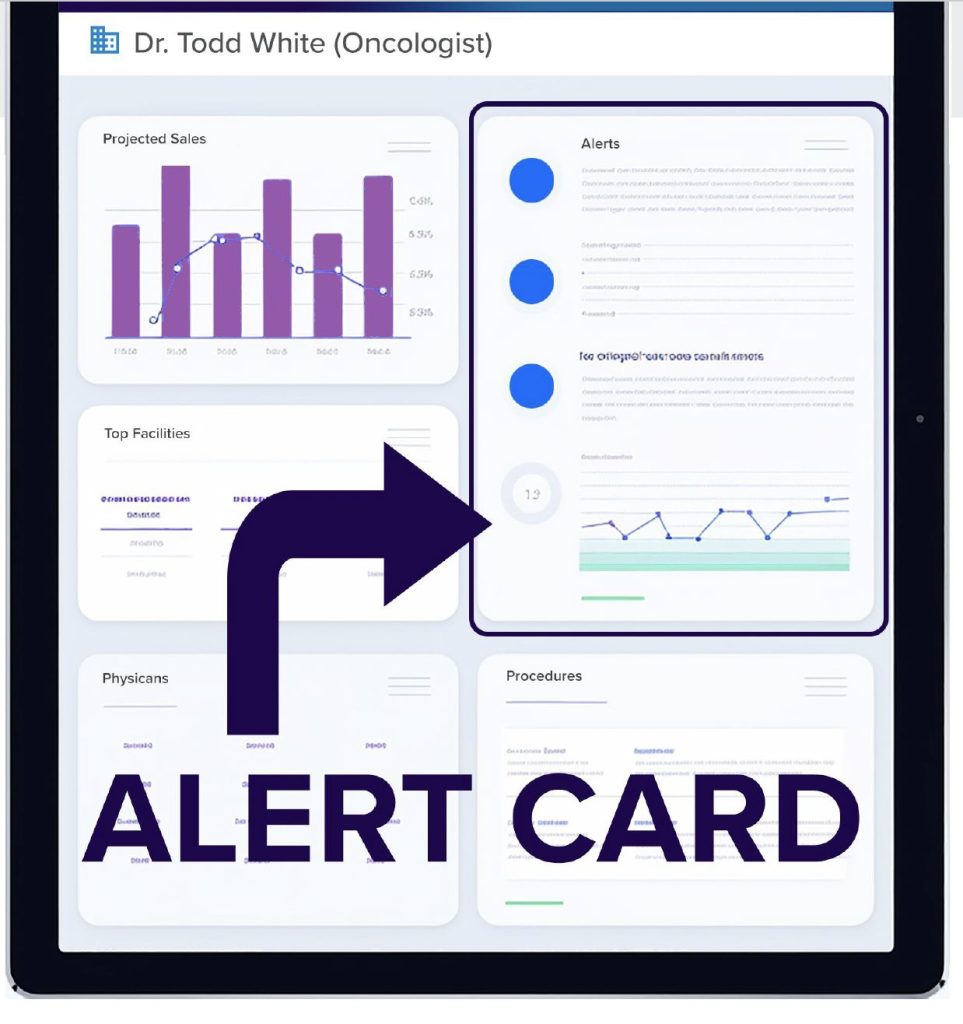
Focused Screens
The application’s screen should be tailored to the specific needs of the MSE. For example, when viewing an Oncology Doctor at Johns Hopkins, an MSE would see key statistics like patient demographics, treatment outcomes, and procedure costs. Features like referral networks, patient ratings, and a profile picture would also be displayed. This focused information ensures a productive interaction between the sales rep and the doctor.
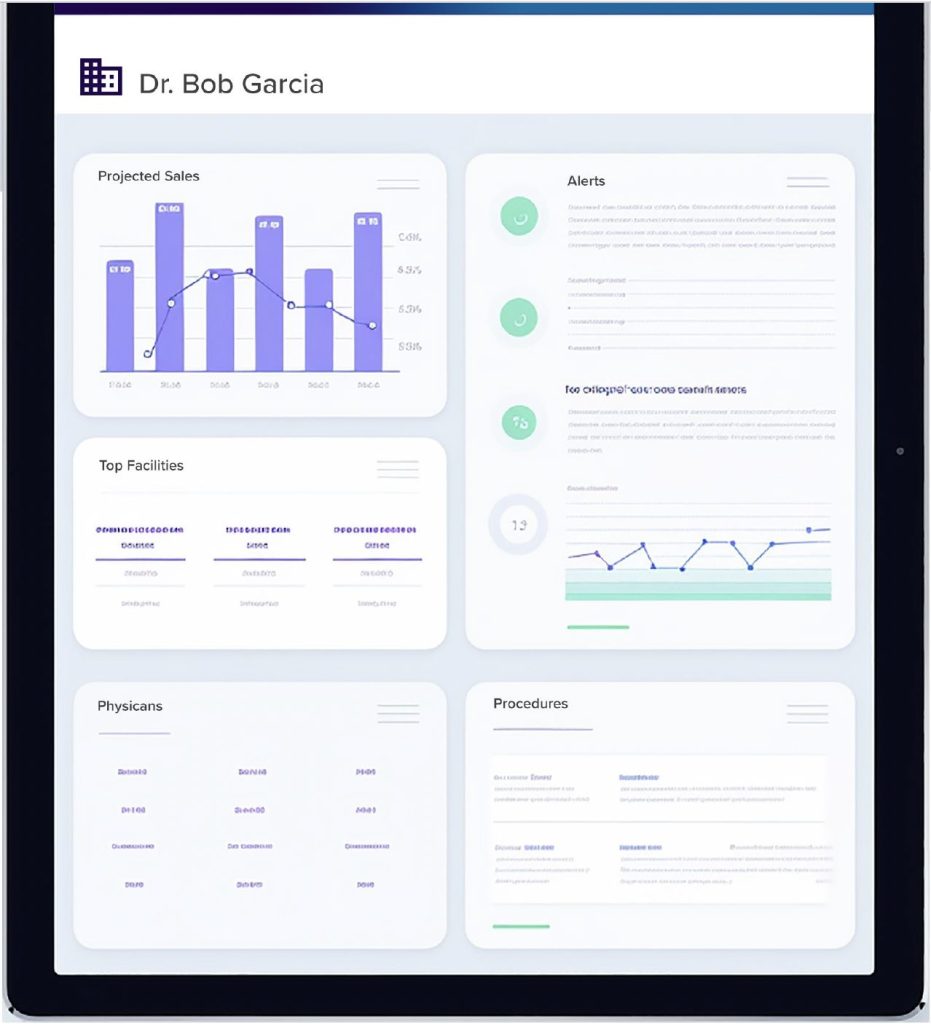
Emphasis on Integrated Essential Data Snippets
In designing the IQVIA MedTech Market Activator Platform, the interface was meticulously crafted to prioritize essential and interconnected data snippets over voluminous tables on the primary dashboard, aiming to facilitate a more streamlined and user-friendly experience.
Drawing inspiration from efficient models like Amazon’s related and competing products feature, the application showcases interconnected data, such as connected physicians, products, or institutions like hospitals, in an intuitive and logical manner. By presenting these interconnected insights that are contextually relevant, users are not only able to access the data they are explicitly seeking but can also discover additional insights that could be crucial for their sales strategies and decision-making processes.

Outcomes
The product, with its intuitive features, is a revolutionary benchmark in user experience within the MedTech sales domain.
The intuitive design and innovative features I incorporated have now set a new benchmark within the organization, elevating the user experience and fostering enhanced user engagement. I’m genuinely optimistic about the app’s potential to revolutionize the MedTech sales domain, enabling users to navigate and leverage data more effectively.
Reflections
The application is adaptive and scalable, ensuring accuracy in degraded data scenarios and continually evolving to incorporate more features.
Plan for degraded data scenarios
This application is only as good as the quality and accuracy of the data. Missing or inaccurate data is common, and the application must accurately convey this to the MSE. Why is a component or chart blank? Did the data arrive? Did the connection work, but the data does not exist? Perhaps sales were not made, and the result is zero. Error information can be easily misinterpreted, causing judgment errors.
Application capable of evolving
The application should also be adaptable, capable of evolving as more features become available to accommodate growing datasets. In the process of continuous improvement, it is crucial to collaborate with the engineering team, aligning design developments with the engineering release cycle, ensuring a harmonious growth of both design and functionality.
Create a plan with engineering to scale the design as features become available.
Engineering will build simple to complex iterations over several releases in a complex application like Medtech. To maintain accurate UX, it is essential to understand this release cycle and have designs that reflect each release. Not all features should be displayed in every set of screens. Providing an accurate design for the current build is a lot of work but keeps design and development aligned.
Final Product
The MedTech application is a fusion of user-centric design and innovative technology aiming to resolve the complexities faced by Medical Sales Executives in data navigation and utilization.
The end result : the PRODUCT
